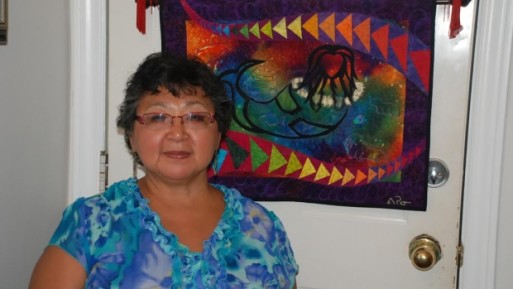
“Pillars of Strength”
(Credit: cbc.ca)
Veronica Puskas, who grew up in Nunavut’s Kivalliq region, won Quilt Canada’s 2014 prize for Excellence in Work by a first-time exhibitor. Her award-winning artwork “Pillars of Strength” is based on a photograph that depicts two figures — her mother and grandmother — standing on the bank of the Meliadine River near Rankin Inlet in 1950.

Veronica Puskas with “Nuliavuk”
(Credit: cbc.ca)
The quilt, says Puskas, honors her grandmother’s life. It also provided her with the opportunity to reflect on the relationship between immediate family, ancestry, land and home. “I hope to encourage people that are going through difficult times that through doing some artwork or doing something to make something beautiful is very cathartic,” she said. “It helps you deal with the emotions and the hurt while doing it.”

Detail of “Pillars of Strength”
(Credit: cbc.ca)
The traditional lifestyle of indigenous peoples living near Rankin Inlet, a culturally and historically pivotal center for Kivalliq, was disrupted in the early 17th century and changed forever with the coming of the Hudson Bay Company in 1717. Later, settler-run mining projects in the area became a main source of income for indigenous residents, as power politics shifted and traditional ways of life became less and less a possibility for those who wished to continue living off the land. The Rankin Inlet Mine was shut down in 1962, leaving its workers (70 to 80 percent of whom were Inuit) unemployed.
While Puskas’ family history may seem specific and remote, it has echoes in the lives of many people who now call North America home.
While Puskas’ family history may seem specific and remote, it has echoes in the lives of many people who now call North America home. While this continent supports approximately 529 million people (according to a 2008 census), the vast majority trace their personal ancestry back to other parts of the world. While the settling of North America displaced and destroyed the lives of many indigenous cultures, the people who came from abroad were also alienated from their own homelands.
It is for this reason that Puskas’ quilt has such a far-reaching resonance. “Pillars of Strength” reminds us all that we are here because our ancestors struggled to survive, not because they were under any delusion that they might live forever, but because they believed that their children might have a better life than they had. We are all born of countless love stories — of parents for their children, of individuals for their communities and traditions, of strangers helping strangers — each one a pillar of strength upon which we each have knowingly or unknowingly built our lives.

 Inuk Woman Wins National Award for Memorial Quilt
Inuk Woman Wins National Award for Memorial Quilt


 John Mulaney’s “Funeral Planning” on Netflix: No Real Plan
John Mulaney’s “Funeral Planning” on Netflix: No Real Plan

 Composting Bodies Is Now Legal in a Dozen States
Composting Bodies Is Now Legal in a Dozen States














